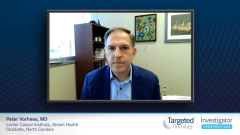
Multiple Myeloma: Clinical Implications of the MAIA Trial
Peter Voorhees, MD, reflects on practical implications of the MAIA trial and how best to manage a patient with newly diagnosed multiple myeloma.
Episodes in this series

Transcript:
Peter Voorhees, MD: The clinical implications of the updated results of the MAIA trial are very clear. Many of us were already convinced that daratumumab-lenalidomide-dexamethasone was a very important standard of care when all we had was a clear improvement in median progression-free survival, but now we have a clear improvement in overall survival as well. It’s very clear that daratumumab-lenalidomide-dexamethasone is a critical standard of care for patients with newly diagnosed transplant-ineligible [multiple] myeloma. As far as which patients I would consider for this regimen, any newly diagnosed patient who’s transplant-ineligible should be considered.
There’s this question that keeps arising: does the addition of a CD38 antibody to a backbone myeloma regimen provide meaningful benefit for high-risk patients? Unfortunately, when you look at each trial, the number of patients with high-risk cytogenetics is so small that it’s hard to infer any significance. When you look at metanalyses, in the relapsed and newly diagnosed settings, the pattern is very clear that there’s an improvement in progression-free survival in both high-risk and standard-risk patients. Anybody could be considered for this particular platform.
What are the implications of the MAIA data with regard to frontline transplant for those who are eligible? That’s an important question. I am 1 of the people who believes that there’s a role for high-dose melphalan consolidation supported by autologous stem cell transplantation. We have data from the IFM 2009 trial that looked at up-front transplant vs deferred transplant in the context of up-front RVd [lenalidomide, bortezomib, dexamethasone] therapy. As we know from that trial, the likelihood of achieving a deep response was higher with up-front transplant. That included an increased rate of MRD [minimal residual disease] negativity and translated into an improvement in median progression-free survival that was statistically and clinically significant.
More recently we have the FORTE trial, which looked at the KRd [carfilzomib, lenalidomide, dexamethasone] backbone with up-front transplant vs delayed transplant with additional 4 cycles of KRd [carfilzomib, lenalidomide, dexamethasone]. In that trial, we found that although the rates of MRD negativity were similar between those 2 arms of the trial, sustained MRD negativity was clearly higher in the up-front transplant arm, and that led to an improvement in progression-free survival for the transplant arm. That’s with the best of what we have to bear in the frontline setting.
If you want to increase your odds of the longest remission possible in the first line, transplant still has a role. Can we use a quadruplet, for example, to obviate the need for transplant? That’s an open question or will the bispecifics of the CAR [chimeric antigen receptor] T-cell therapies that are emerging replace transplant? It’s possible, but we’ll need those randomized trials to determine that, and we don’t have that data. My advice is to get the transplant in frontline. Patient preference is absolutely critical in decision-making, and patients may have very strong preferences about when or if they’ll do transplant. For those who have low-risk disease, perhaps hyper diploid myeloma with no high-risk cytogenetics, who very strongly want to avoid transplant, it would be very reasonable to collect stem cells for that patient and reserve transplant for first relapse.
Transcript edited for clarity.









































